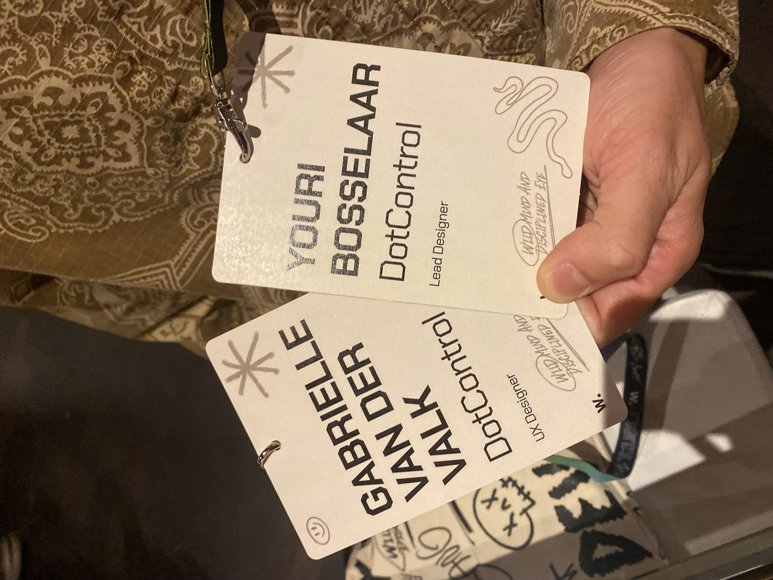Digital Humans are here (to help)
People are supposed to be physical beings… right? Well, at this conference we were introduced to not one, but two key aspects of humanity becoming digitized.
First off, Peter Smart gave us a sneak peek into Fantasy’s version of the digital human character. Based on a huuuge set of data from real-world people, Fantasy created “Synthetic Humans”. By chatting with this set of AI personalities, you can learn all about their artificial lives and backgrounds. This opens loads of interesting opportunities for User-Centered design, and we can’t wait to learn more on how we can combine real-life UX methods with this new tool.


While Fantasy focusses on digital characters, Canadian agency Locomotive took a different path and did some amazing work in digitizing their own human bodies. They went all-in for their agency website, experimenting with animated 3D models. The result? An interactive 3D “Our team” page – the coolest we’ve seen in a long time! We’ve already been experimenting with 3-d scanning, but Locomotive surely inspired us to take things even further.
Don’t make your brand a one-night stand
You’re in the heat of the moment. Somewhere deep inside, you know that this might not be the best idea on the long term, but it’s just so damn tempting. We’re talking – obviously – about doing quick fixes for your website or campaigns that optimize for short-term results but might sabotage you from building a strong and memorable brand.
As Apple’s Creative Director Graham McDonnell’s nicely put it: “Don’t be what’s interrupting, be what’s interesting”. Graham’s talk was yet another reminder that there is much more value in building a long-term relationship with your customers. Instead of pushing them over the edge for that one-time single conversion.
Being a data-driven agency, a key aspect of our role is to think broadly about how success should be measured. We help clients improve short-term metrics, but also safeguard that they navigate towards their longer-term brand vision and ambitions. As Freddie Öst and Erik Kockum of said: “A good brand speaks to the heart”.

AI AI AI
It won’t come as a surprise that AI was by far the most frequently mentioned term in the conference. And although the AI buzz has been going on for quite a while, we still came home with some new technologies to explore in the realm of Generative AI for Design.
Both Peter Smart from Fantasy and Yordi van der Werf & Ewould Offenberg from Ronin shared ideas on how to leverage tools like usegalileo.ai and UIzard in a design process. These tools enable designers to quickly create AI-generated, hi-fi designs for User Interfaces (UI) based on text input. For now, the generated outcomes will surely not be fully ready for development. But they do enable us to swiftly generate multiple design variations as a basis for layout ideas, A/B testing and concepts. A nice potential extension of our ideation toolkit!
Things are moving at an incredible pace. And so, we wonder... how soon will we be generating interface designs with AI, fill them with AI-generated text and images, then testing them with AI persona’s and finally develop the real side through AI code generation?
Need ideas? Remember the real world
Confession time: the first reflex of every digital designer who runs out of ideas is to go check out cool projects on the Awwwards website. Just ask any designer. It’s true. Yet even though Awwwards hosted this event, many of the speakers told us to go spark ideas elsewhere.
They once again reminded us that there are loooads of ways to generate truly new ideas. Most of them with more potential than simply looking at work that already exists within the same industry. Here are some approaches that we’ll surely use to take a fresh look at our design challenges ahead:
- Use culture as a strategic asset. Look into society and the cultural landscape. Find out what’s keeping people busy and use that to trigger new perspectives on your upcoming challenges. (Wonderland)
- Embrace the mess. Be 90% reliable and 10% rebel. Sometimes you need to stand out. Look at what everyone else is doing, then try the opposite. (Lu Yu).
- Look outside our industry. For example, trends in aesthetics often pop up in fashion or interior design before they do in digital. (Pelle Martin)
A fruitful conference indeed. With these interesting ideation techniques, new tools and technologies, and a revamped focus on building long-lasting experiences, we are more than ready to create amazing new work. Maybe even for, or with you?
